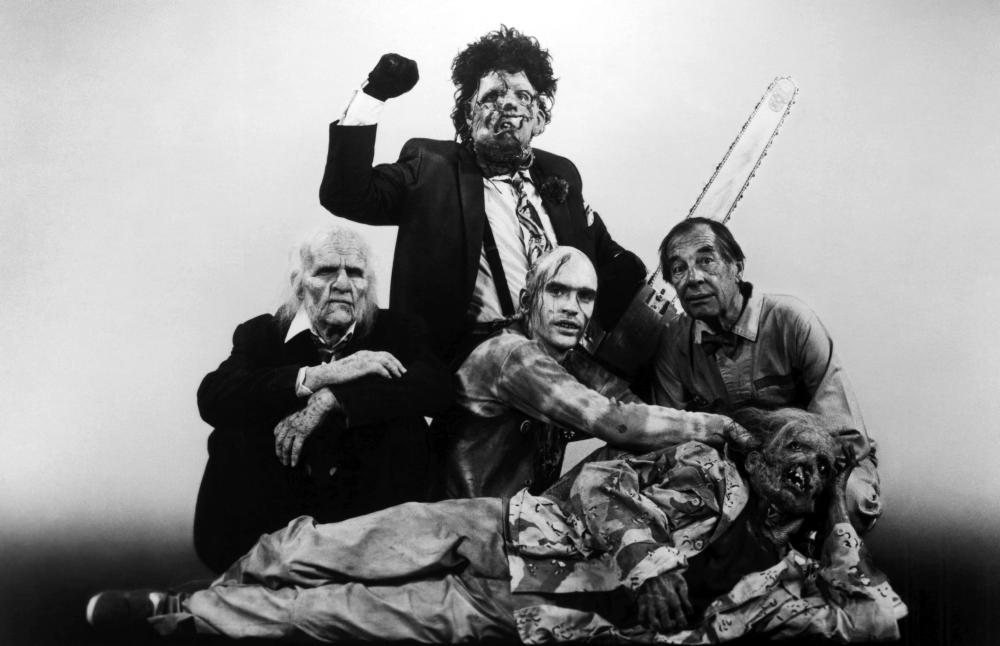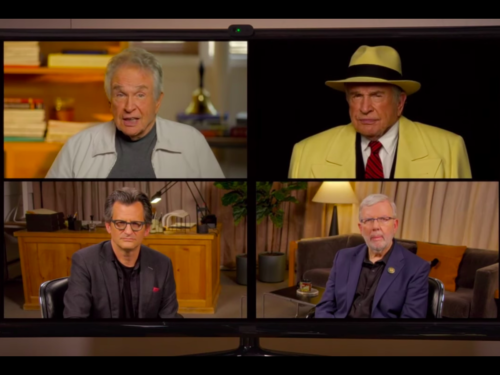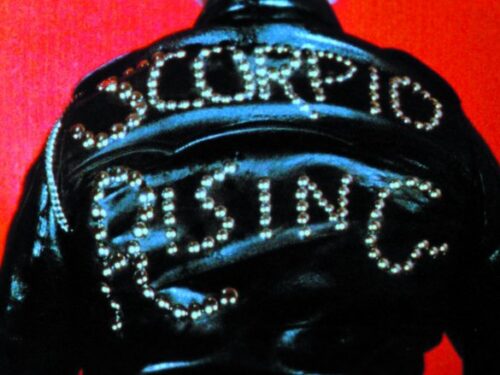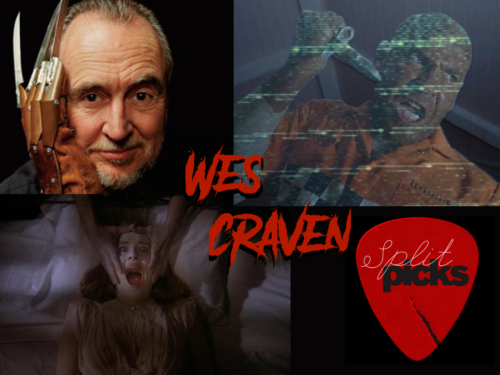A shot of neon-lit adrenaline that’s best experienced on an empty stomach, Tobe Hooper’s disorienting sequel disregards all intentions of a continuing saga
The first three spots on American Horror’s Mount Rushmore are easy to fill. Each filmmaker enjoys a prominent place, carved in stone in any genre fan’s personal pantheon. They’re three Washingtons or three Lincolns; take your pick.
With The Last House on the Left, Nightmare on Elm Street and Scream, Wes Craven reinvigorated that most disreputable of genres in three straight decades. George Romero all but invented our modern idea of the walking dead and imbued his films with searing social critique. John Carpenter — still with us — has left directing to tour as a musician, but his impact on the genre remains immense. Few would dispute his status as Horror’s Auteur Emeritus.
The fourth spot’s a little harder to fill. Craven, Romero and Carpenter kick-started franchises, designed iconic characters and helped elevate their preferred genre to the stuff of art. But even they struggled to secure funding and critical respect throughout their long careers. The likes of Scream 4, Bruiser and The Ward certainly have their defenders, but they also complicate any argument in favor of their directors’ artistic bona fides. Esteemed as they are, each auteur is considered (however erroneously) to have worked well past their prime.

That’s triply true for the filmmaker I’d choose as Mount Rushgore’s fourth giant head: Tobe Hooper. Only the world’s most dedicated contrarians ever call The Texas Chain Saw Massacre’s quality and influence into question. It’s every bit as game-changing and genre-defining as Halloween, Night of the Living Dead or Scream. The same is rarely said, however, for any of the dozen-plus features that would follow. Even Poltergeist — another celebrated classic — was more a source of shame than a calling card. Rumors that Steven Spielberg really directed the film have outlived Hooper and still make it all too easy to dismiss him.
Juxtaposed against these three giants, Hooper’s place in American Horror looks especially strange. Certainly the least respected of the quartet, he’s also unique among them in at least one key sense. That is, he took it upon himself to reenter his flagship franchise after a long absence and take it into new, deliberately alienating territory before anyone else could get their hands on it. Carpenter abandoned Michael Myers only to return (as composer and executive producer) for David Gordon Green’s reverent-to-a-fault reboot. Craven let Elm Street fall victim to franchise hackery while keeping Scream to himself and realizing — with the fourth installment — that imitators had sapped the franchise’s impact. Romero was more resolute, keeping his zombies and their quasi-franchise to himself and reaping severely diminished returns.
More October Horror: Martin: Searching The Soul Of An Incel Vampire In 2019 (George Romero, 1977)
Hooper took a different approach. Rather than leaving Texas Chain Saw Massacre’s carcass to be picked apart by franchise-hungry opportunists or dragging its bloated corpse through his own series of dead-eyed sequels, he used his lone follow-up as an opportunity to commit cinematic self-sabotage. Hooper didn’t return to the murderous Sawyer family to plant the seeds for a Texas Chain Saw Massacre franchise. He did it to salt the fields. In a sense, he succeeded. Part III barely registers for even the series’ biggest fans and The Next Generation’s Oscar-winning leads are only the most famous people who pretend it doesn’t exist.
With Texas Chainsaw Massacre 2 (1986), Hooper doesn’t opt for the callbacks and inside jokes that define current day franchise filmmaking. Nor does he look to establish a framework for eventual sequels. He’s as disinterested in making things easy for his successors as he is satisfying fans of the first film. In an era where ‘the fans’ exert undue influence, Hooper’s lack of reverence looks especially daring.
The insufferable discourse around franchises has recently seen old masters dismiss the endless stream of superhero sequels as “theme park rides.” It’s ironic, then, how much Texas Chainsaw Massacre 2 — so hostile to the notion of a franchise — actually calls to mind the experience of riding a roller coaster. It’s a shot of neon-lit adrenaline that’s best experienced on an empty stomach, as nauseating and disorienting as it is thrilling. Its climax even takes place in an underground funhouse that must have inspired the roadside attraction at the center of Rob Zombie’s House of 1000 Corpses.
More October Horror: Joel Potrykus’ Midwestern Monsters Pt. 1: Ape and Relaxer
There’s more irony in Roger Ebert’s withering, one-star takedown of the film. Characteristically off-base on the subject of horror, Ebert draws an unfavorable comparison to Hooper’s breakout. “Part 2,” he writes, “has a lot of blood and disembowelment to be sure, but it doesn’t have the terror of the original, the desire to be taken seriously. It’s a geek show.” That lack of self-seriousness is exactly what makes the film so essential, even strangely prescient.
Hooper appears to both predict and undercut the pretension that would define films like 2003’s remake of The Texas Chainsaw Massacre. Ebert repurposed his favorite insult for an even more scathing takedown of that Michael Bay-produced slog. This time, he’s mostly onto something. In addition to replacing the original’s muted, sunbaked grime with the look of an Abercrombie & Fitch ad from Hell, the film luxuriates in its grotesqueries. For director Marcus Nispel, the “materials of a geek show” include torn-out fingernails, salted wounds and a lingering look at the misshapen face behind the infamous leather mask. It makes it easy to forget that the original film — however suggestive its title — is relatively light on gore. It’s a prescient film in its own way, prefiguring the miserablist, much-maligned “torture porn” that would follow throughout the early aughts. Worse still, there’s a strained authenticity to its “newsreel footage” and grave voiceover narration. It promises to bring us into a set of real-life case files and begs us to take it seriously.
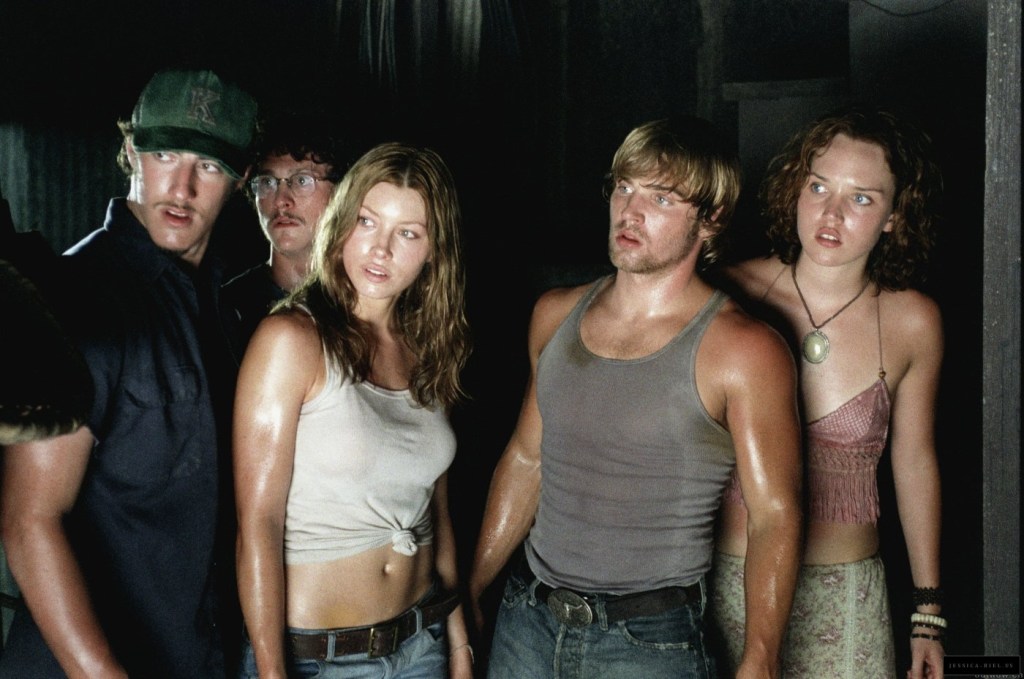
Texas Chainsaw Massacre 2 succeeds because Hooper fearlessly subverts and lampoons his own work. The film opens with a voiceover of its own; it provides the film its one and only solemn minute. Referring directly to the original, the narrator relates the harrowing experience of lone survivor Sally Hardesty-Enright (Marilyn Burns). Following her narrow escape, she “babbled a mad tale” before sinking into catatonia. Thirteen years later, “Texas lawmen” have yet to prove the crimes occurred, let alone identify the culprits: “On the records, The Texas Chainsaw Massacre never happened.” It has, nevertheless, continued on and on in rumors and unexplained reports. “It haunts Texas,” the voiceover concludes, “It seems to have no end.” It must have haunted Hooper too. From here, he does everything he can to bring the story of Leatherface and his family to a definitive, disgusting and disrespectful end.
The first film and its remake both operate within the classic slasher mold. They follow groups of young people who — save for the requisite final girl — get picked off one-by-one. The sequel rejects this format almost immediately. Its own rowdy youths run into Leatherface (Bill Johnson) within minutes as they make their way to “the number one party of the world.” Their grisly deaths come shortly after they’ve shot bullet holes into a number of roadside signs — including a reminder to “Remember the Alamo.” In their final moments, they echo their director’s attitude toward history and tradition. They also dial into a local radio station, broadcasting their demise to listeners across Northeast Texas and making Stretch (Caroline Williams) an unwitting witness.
More October Horror: The Town That Dreaded Sundown (Charles B. Pierce, 1976)
Disturbed, the DJ makes a recording that soon makes her a target for Leatherface and his family. No longer relegated to a dusty gas station in a forgotten corner of Texas, the Sawyers now run an award-winning small business. The “real good barbecue” promised by Drayton “The Cook” Sawyer (Jim Siedow) back in 1974 has gotten even better. Drayton has become a respected member of the community thanks to his delicious chili and its half-secret recipe. “It’s all about the meat,” he reminds his adoring fans, leaving out just one small detail. While Hooper only implies cannibalism in the first film, it’s now explicit and brazenly comedic. What Ebert and countless purists consider an affront, I consider an argument in favor of Hooper’s bold, anarchic vision. He’s taken the events of Texas Chain Saw Massacre to the only absurd conclusion possible. Though it takes place more than a decade after its predecessor, it appears to emerge directly out of that film’s final moments. Its commercialized carnage and buckets of Tom Savini blood reflect a world that’s stuck, like Sally, between screams and deranged laughter.
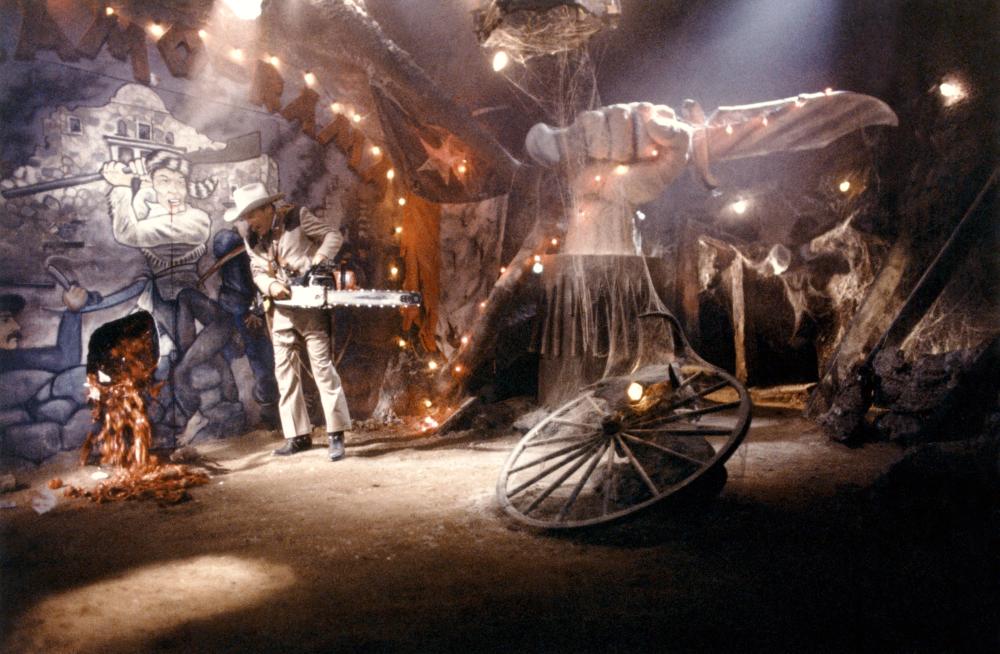
A stalwart of this insane society, Drayton has a reputation to protect. He sends Leatherface and Chop Top (Bill Moseley, upstaging Leatherface at every turn) to silence Stretch. Here he subverts the structure of Texas Chain Saw Massacre once again. Stretch doesn’t happen upon the Sawyer family after straying too far from polite society. Rather, she becomes their target by threatening to expose them as monsters hiding in plain sight. Following a narrow escape, she finds an ally in Lefty (Dennis Hopper). In Hopper’s unhinged character, Hooper himself finds yet another tool to undercut the grim groundwork laid throughout his original film. Lefty was related to Franklin (Paul A. Partain), one of Part 1’s four victims. He has spent the last thirteen years hunting for the chainsaw-wielding maniac responsible and telling everyone who’ll listen that the killers are still at-large. Other lawmen dismiss his warnings outright as absurd fantasies. After all, Lefty is an absurd character. He’s the embodiment of everything that is absurd about taking a horror movie killer seriously and — like the Sawyers themselves — a product of a world haunted by violence and infected with gleeful bloodlust. Wielding multiple chainsaws at once, he cuts a ridiculous, chaotic figure and styles himself as the only possible answer to Leatherface.
During the film’s carnivalesque climax, Lefty becomes a mouthpiece and an avatar for his director. He embarks on a suicide mission deep within the Sawyers’ stronghold. Not content to eliminate the family alone, he aims his chainsaws at support beams, shouting “take it all down!” Whatever the consequences, he hopes to ensure the world never sees another Texas Chainsaw Massacre or Texas Chain Saw Massacre again. “The Lord of the Harvest” leaves just Stretch and Chop Top alive to duke it out atop the crumbling structure. In one last reversal of the original film, our final girl grabs a chainsaw of her own, defeats her attacker and ultimately stands alone atop the rubble. She flails, wails and waves her chainsaw in the air like Leatherface did 13 years earlier.
For all their superficial similarities, the climactic sequences provoke far different feelings. Leatherface’s sunlit dance implies a world of horror still to come, whether in sequels or in our nightmares. Stretch’s final moments bring things to a definitive close. In killing the Sawyers, she’s brought an entire world and would-be franchise down with her. Is she crying out in triumph or in terror? I expect Hooper would say the former.
Purchase The Texas Chainsaw Massacre 2 on 4K UHD/Blu-ray from Vinegar Syndrome
Stream The Texas Chainsaw Massacre 2 on Amazon Prime
Follow our list of the 31 Days of October Horror on Letterboxd
(Split Tooth may earn a commission from purchases made through affiliate links on our site.)
Find the complete October Horror Archive here:


